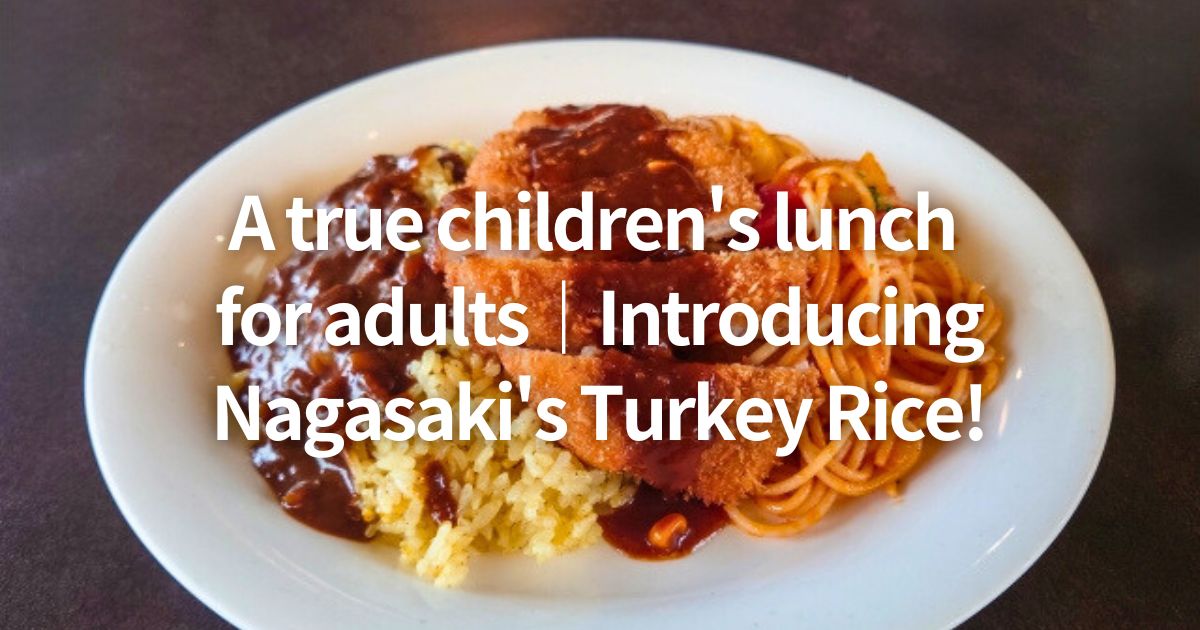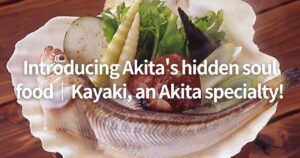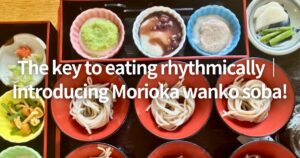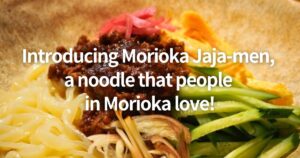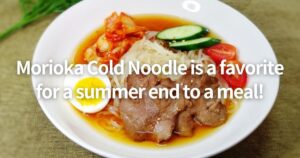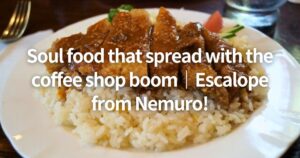There are many reasonably priced and tasty foods in Kyushu compared to Tokyo, and I would highly recommend the Turkish rice in Nagasaki.
What is Turkish rice? Many of you may be wondering.
Turkish rice is a dish consisting of consommé-flavored pilaf with onions and green peppers, Neapolitan, and pork loin cutlet on a single plate.
Turkey rice is a hearty and calorie-dense combination of the mainstay dishes, but its appearance is that of a grown-up’s kid’s lunch.
There are many theories about the origin of turkish rice, and it is served in various regions of Japan, but the most famous version is served at coffee shops and other restaurants in Nagasaki.
So, in this article, I will explain about the history, appealing points, recommended famous restaurants and sightseeing spots around Nagasaki’s turkish rice, including my experience.
I hope you will find this a good opportunity to learn about Nagasaki’s Turkish rice.
Why is it called “Turkish Rice” in the first place?


Although Turkish rice has “Turkey” in its name, it is not actually a Turkish dish.
There are many theories as to the origin of the name.
Despite the name “Turkish,” it is unlikely to have originated in Turkey, where many Muslims forbid the eating of pork, and it is not directly related to Turkey.
The main theory is that there is a Turkish dish called pilau, from which the word pilaf is derived, and that the pilaf in Turkish rice is derived from this Turkish dish.
Another theory is that the name “Turkish rice” is not derived from the country’s name, Turkey, but from the word “tricolor,” which is a pun on the word “tricolor” to describe a three-colored dish.
Another popular theory is that the name “Turkish rice” came about because the mix of food cultures – French pilaf, Japanese pork cutlet, and Italian spaghetti – is reminiscent of Turkey, where the cultures of East and West intersect.
How did Nagasaki’s Turkish rice come about?


The date of origin of Turkish rice is not clear, but based on testimonies from locals and stories of famous people from Nagasaki, it is believed to have been created in the 1950s.
The restaurant that first served turkey rice is also not known for sure.
One popular theory is that it was created and named by Miyoji Matsubara, a chef at Restaurant Marzen.
It is said that the name was inspired by a woman’s fine dress, with the upper half of the body as rice, the obi as cutlets, and the kimono’s gaudily patterned hem as spaghetti.
Turkey rice has been a popular Nagasaki treat since that time, but it is only recently that it has gained nationwide recognition.
Through the limited menu items at convenience stores and the efforts of chefs from Nagasaki, it has gradually become a local dish that is well known throughout the country.
There are many theories about the origin of turkish rice, and the fact that its birth is still unclear is both mysterious and interesting…
Three Attractions of Turkey Rice in Nagasaki


I have summarized some of the attractions of Nagasaki’s Turkey rice.
Creativity with a variety of combinations
It is no exaggeration to say that there are innumerable combinations of Turkish rice in Nagasaki, which is also called “children’s lunch for adults,” with pork cutlet replaced by chicken cutlet or hamburger steak, or pilaf flavored with consommé or curry, depending on the restaurant.
Famous restaurants such as Nicky Austin in Nagasaki offer more than 180 varieties of Turkish rice.
With a choice of curry, dry curry, or hashed rice for rice, pork cutlet, chicken cutlet, hamburger steak, or croquettes for toppings, and several different pastas and sauces to choose from, the combinations are so numerous that one could go to a restaurant many times and still not eat enough.
In addition, visitors can enjoy the pleasure of finding and tasting different types of Turkish rice at Western-style restaurants, set menus, and cafes throughout Nagasaki, each with its own unique flavor.
For foreign visitors to Japan, the unique evolution of familiar Western cuisine in Japan provides a valuable opportunity to experience the diversity of Japanese food culture.
Exquisite taste harmony and satisfaction
Turkey rice is a dish that is “a combination of the main dishes” and is characterized by its volume and satisfaction.
For example, at restaurants such as Ginrei, diners can enjoy “elegant” Turkish rice, which has been described as “the pilaf, cutlet, and spaghetti in Turkish rice are each too assertive and can become boring halfway through eating, but the Turkish rice here is very well balanced.
The basic style of Turkish rice is “Pilaf and Neapolitan spaghetti topped with pork cutlet in demi-glace sauce,” but there is also a wide variety of sauces, from the traditional demi-glace sauce of “old-fashioned Turkish rice” to different sauces for the cutlet and spaghetti, meat sauce, tomato sauce.
You can enjoy a wide variety of flavors such as meat sauce, tomato sauce, carbonara, etc.
The ability to enjoy multiple flavors on one plate at the same time has earned the restaurant a high reputation among foreign tourists who enjoy food adventures.
A historical dish that symbolizes Nagasaki’s multiculturalism
Turkey rice, Nagasaki’s local dish, can be described as “a gourmet dish that is typical of Nagasaki, a city of diversity where cultures from many different countries are fused together in a single dish.
Turkish rice has a variety of dishes from different countries, such as Middle Eastern pilaf, Italian spaghetti, and Japanese pork cutlet,” he said.
There is even a theory that it was called “Turkish rice” because of its resemblance to Turkey, a country of multiculturalism.
It is estimated that Turkish rice was born in the 1950s and 1960s, and although its origin is still shrouded in mystery, it is a unique dish born of the food culture of Nagasaki, a city that flourished as an international port.
When introducing Nagasaki to foreign visitors to Japan, this dish is a must-try as it symbolizes the history of Nagasaki, where cultures from the East and West intersect.
You can enjoy various combinations and many variations, so it’s good that you can compare different foods without getting bored.
My recommendation for the best Turkish rice restaurants in Nagasaki
In this article, I will introduce some of the best restaurants in Nagasaki that I recommend and their recommended menus.
My recommendation for the best Turkish rice restaurant in Nagasaki
My recommendation for the best Turkish rice restaurant in Nagasaki
Tsuruchan Main Restaurant


✅ Recommended Points
- Founded in 1925, Tsuruchan is Kyushu’s oldest coffee shop and a long-established representative of Nagasaki’s Western food culture.
- The name “Tsuruchan” comes from the fact that Nagasaki Port is familiarly known as “Port of Cranes,” meaning “the first coffee shop born in Nagasaki, the Port of Cranes.
- The retro interior of the store, with its 98 years of history, including celebrity autographs covering the walls and old photographs from the time of its establishment, has become a tradition of Nagasaki sightseeing.


✅ Recommended menu
- Old-fashioned Turkish Rice
- The recommended menu item is the “Old-Fashioned Turkish Rice” (1,380 yen).
- It is a traditional dish consisting of pork cutlet, Neapolitan, and butter pilaf, topped with a special curry sauce.
- The curry sauce has a unique coffee shop flavor that harmonizes “mild and thick richness” with “gentle stimulation felt at the back of the tongue,” and is not nearly as spicy as other curry sauces.
- In addition, a total of 11 types of Turkish rice are on the menu, including “Seafood Turkey” (fried head shrimp and various seafood in white sauce) and “Zipangu Turkey” (pork cutlet with teriyaki sauce & mayonnaise in a Japanese style arrangement).
Himawari Tei
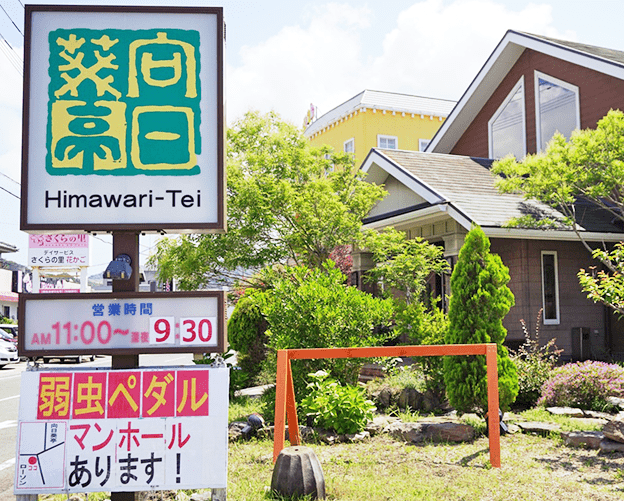

✅ Recommended Points
- Mukohanobori-Tei is a Western-style restaurant located in Kyodomari, Nagasaki City, and is a popular restaurant that serves turkish rice as Nagasaki’s soul food.
- It is highly regarded by residents of the prefecture as having many dishes unique to Nagasaki, hearty and delicious, and features a wide variety of Turkish rice dishes.
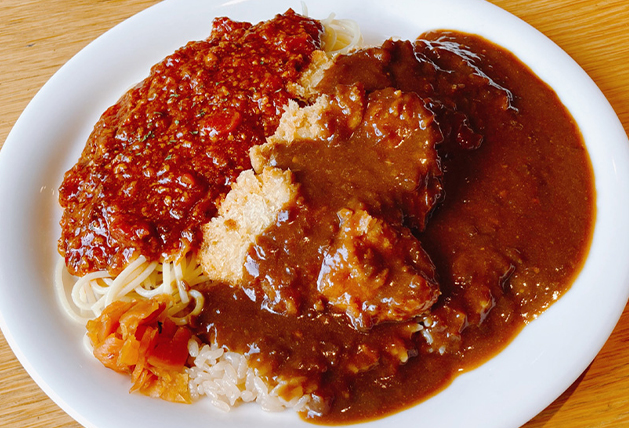

✅ Recommended menu
- Himawari-style Turkish Rice
- The signature dish is the “Mukohi-no-Kaze Turkish Rice.
- It is characterized by its light and tender filet cutlet, pilaf with a special Japanese sauce, and curry sauce made with plenty of onions that have been slowly sauteed and sweetened.
- The spaghetti is served with a choice of meat sauce, tomato sauce, carbonara, or any other sauce you prefer.
- Furthermore, in addition to the main dish of filet mignon, customers can choose from a variety of toppings such as fried shrimp and hamburger steak.
- Female customers can also enjoy the option of topping their Turkish rice with a fluffy omelette.
Croquette


✅ Recommended Points
- Croquette is a popular Western-style restaurant located in Higashifurukawa-cho, Nagasaki City, not far from Megane Bridge.
- As the name suggests, croquettes are the specialty of this popular restaurant, and many tourists stop by when sightseeing at Megane Bridge, and there is always a long line of people waiting in line.
- The restaurant has a long history dating back to 1975 and has been loved by everyone for more than 40 years.
- The croquettes, as well as the sauces and dressings, are all handmade, preserving the unchanged taste.


✅ Recommended menu
- Turkey mix
- The signature dish is the “Turkey Mix” (1,080 yen).
- It is a luxurious dish consisting of fried rice-like pilaf with a variety of ingredients, chewy Neapolitan, and topped with “2 croquettes + 1 country croquette”.
- The croquettes, the restaurant’s specialty, are “crispy on the outside and tender on the inside!
- The crispy, crunchy batter and creamy, tender inside are highly praised by local residents, who say that they cannot be reproduced at home.
Oh. Even within the same Turkish rice dish, each restaurant has its own unique characteristics, so it’s very difficult to decide which one to try…
Column: Is it true that there is Turkish rice outside Nagasaki?


Turkey rice is well known as a local delicacy in Nagasaki Prefecture, mainly in Nagasaki City, but in fact, it is known that “there are also different types of turkish rice outside of Nagasaki, such as in the Kansai region, Yokohama and Kawasaki areas.
In Kobe in the Kansai region, it is called “fried rice topped with curry roux and a raw egg,” in Osaka, “chicken rice topped with a bite-sized pork cutlet and demi-glace sauce,” and in Yokohama, “chicken rice with a pork cutlet in between. In some areas, it is called Turkey Rice.
In Kyoto, the Western-style restaurant Norakuro serves “ketchup-flavored stir-fried rice topped with a bite-sized pork cutlet with egg and demi-glace sauce,” which is sometimes described as “Western-style pork cutlet rice bowl.
Other similar dishes exist in other parts of Japan, such as “Volga Rice” in Takefu, Echizen City, Fukui Prefecture, and with the popularity of Nagasaki’s Turkey Rice, it is now offered at restaurants opened by chefs from Nagasaki or added to menus outside the prefecture, spreading nationwide.
Heh. There are so many different kinds of turkish rice all over Japan. It would be interesting to travel around Japan on a Turkish rice tour…
Recommended places to stop by in Nagasaki while dining
Here are three recommended places to stop by in Nagasaki during your meal.
✅ Glover Garden
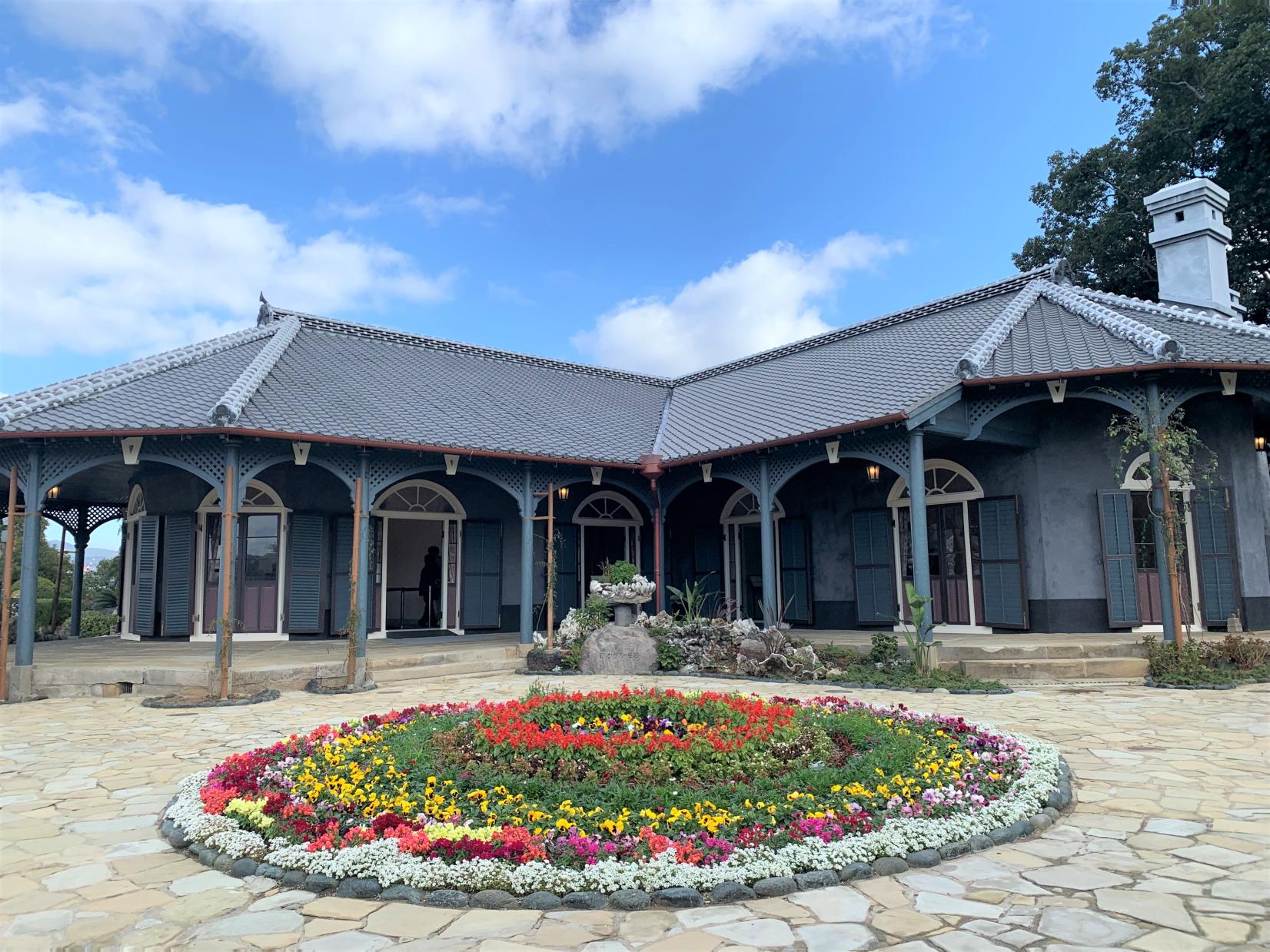

Glover Garden is one of Nagasaki’s most popular tourist attractions, located on Minami Yamate Hill overlooking the panoramic view of Nagasaki Port.
Centered on the residence of Thomas Blake Glover, a Scottish trader, six Western-style buildings from the Meiji period scattered throughout the city have been relocated and restored, with the former Glover Residence, Ringer Residence, and Alt Residence, designated as National Important Cultural Properties.
The park’s main attractions are the cobblestones and stone steps that retain the atmosphere of the 19th century settlement era, and the scent of history and culture wafts through the air.
The park also offers a spectacular view of Nagasaki Port and Mt. Inasa, a “heart stone” that is said to “bring love to life” when touched, and a garden decorated with flowers of the four seasons.
After eating Turkish rice, take a stroll through the exotic garden and experience the history of the garden and its contribution to the modernization of Japan.
✅ Megane Bridge
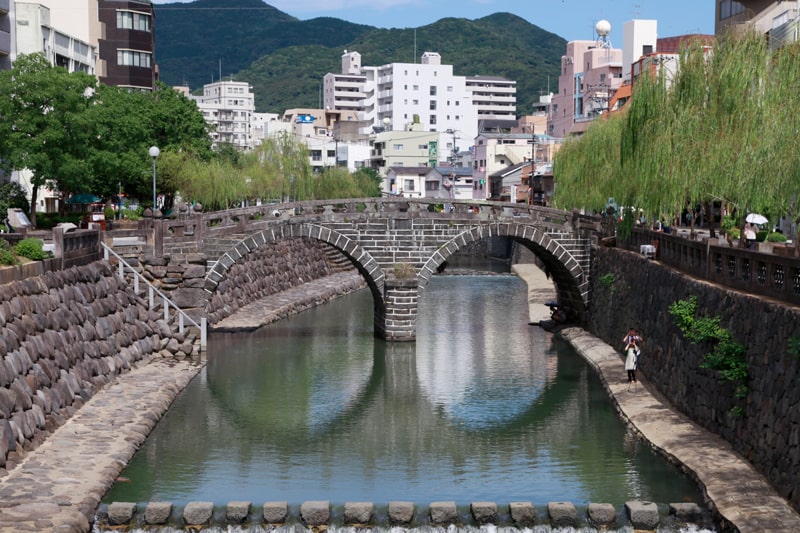

Megane-bashi Bridge is a historical structure said to have been built in 1634 by Zenji Mokusunyojo of Kofuku-ji Temple.
The bridge was so named because the shadow on the river surface looks like a pair of glasses, and is one of the three most famous bridges in Japan, along with “Nihonbashi” in Tokyo and “Kintai-bashi” in Yamaguchi.
The bridge partially collapsed during the Great Nagasaki Flood of 1982, but was restored the following year and is now designated as a National Important Cultural Property.
During the Nagasaki Lantern Festival, which is a winter tradition, the area around Megane-bashi Bridge is decorated with lanterns, attracting even more people than usual.
Many Turkish rice restaurants are located around Megane-bashi Bridge, where you can enjoy a meal together with the beautiful historical buildings.
✅ Dejima Island


Dejima is a man-made island that flourished as Japan’s only window to the West during the period of national isolation.
Completed in 1636, it was initially inhabited by the Portuguese, but was later settled by the Dutch, who played a major role in Japan’s modernization for about 200 years.
After Dejima’s role was completed in the Meiji period, it was reclaimed and lost its original form, but restoration work began in 1951, and today, the island’s buildings and materials excavated during excavations are exhibited to show how life was during the Edo period.
Highlights include the “Kapitan Room,” which was the office and residence of the head of the Dutch trading house, and other buildings from the period of national isolation; the former Ishikura, which was the warehouse of the Hatman Trading Company, which was visited by the Kaientai led by Ryoma Sakamoto in the closing days of the Edo period; and the former Dejima Seminary and the former Nagasaki Naigai Club, which were Western-style buildings built in the Meiji period.
Along with the Turkish rice, this is a spot where visitors can experience the rich history of Nagasaki’s food culture, which was born from exchange with foreign countries.
There are many sightseeing spots concentrated with history, nature, and culture, so please stop by if you are in the neighborhood.
Let’s go to Nagasaki to enjoy the real taste!
The best way to enjoy the authentic taste of Nagasaki’s Turkish rice is to go there and enjoy the atmosphere, so I would like to recommend some items that would be great to bring along on your trip.
In this article, I would like to introduce some of my recommended travel items that can be purchased on Amazon.
I hope you will find them useful when considering travel items.
If you are interested, check out the following products on Amazon!









